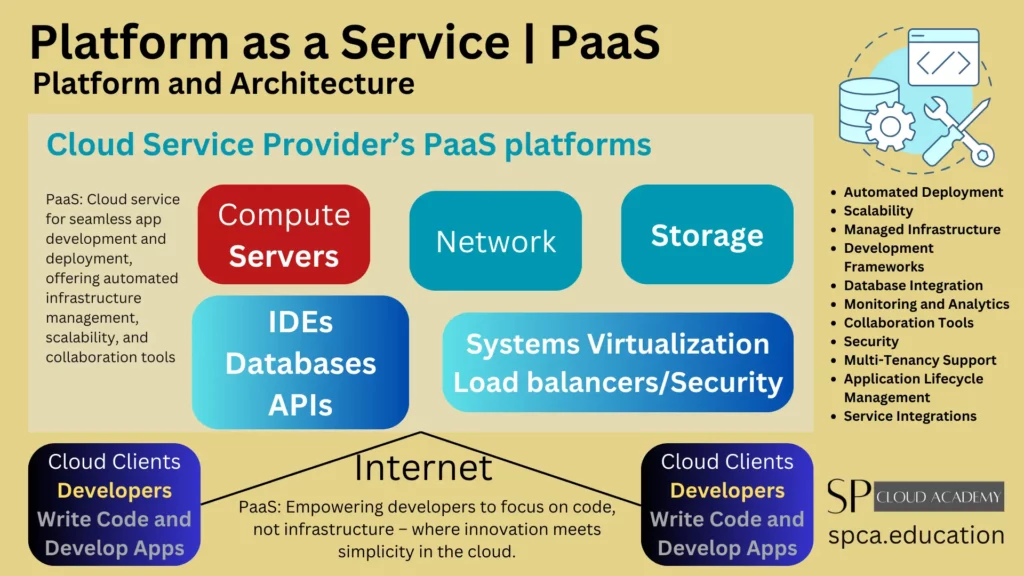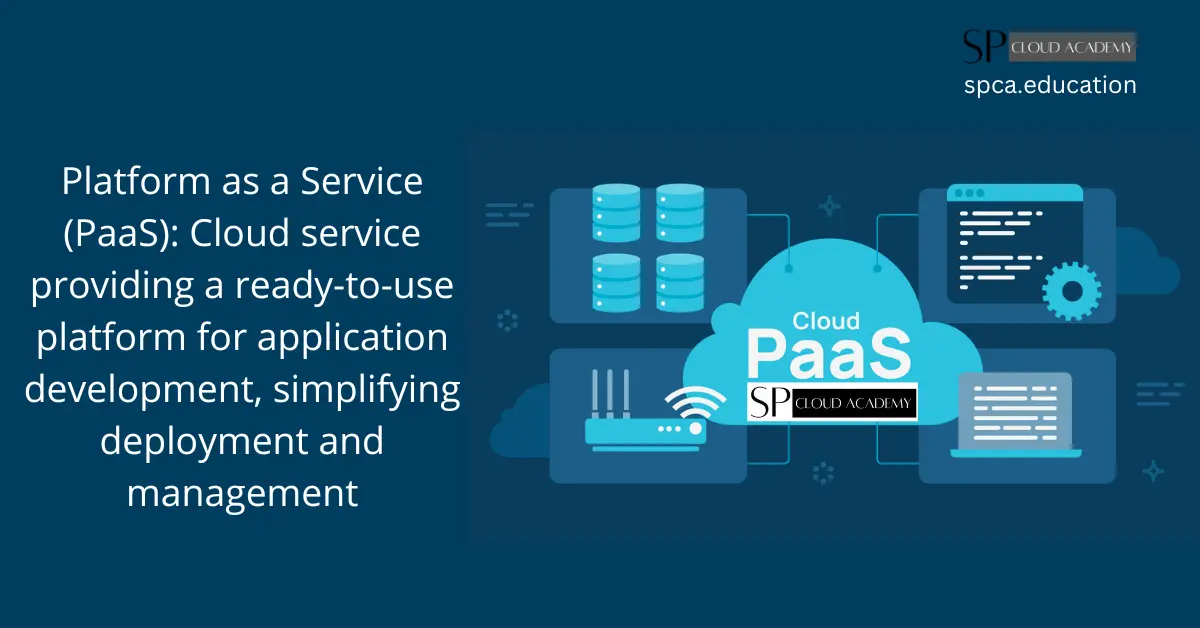Embracing the potential of cloud computing is no longer a choice; it’s a strategic imperative for businesses eyeing growth and innovation. Platform as a Service (PaaS) has emerged as a game-changer, empowering organizations to transcend traditional IT limitations and unlock unparalleled agility. In this article, we delve into the realm of PaaS, uncovering its transformative capabilities, and exploring how it can catalyze business evolution.
Understanding Platform as a Service (PaaS)
Platform as a Service (PaaS) is a cloud computing model that provides a platform allowing customers to develop, run, and manage applications without the complexity of building and maintaining the infrastructure typically associated with developing and launching an app. PaaS offers a complete development and deployment environment in the cloud, making it easier for developers to build web or mobile apps without worrying about setting up or managing the underlying infrastructure of servers, storage, network, and databases.

PaaS not only accelerates the development process but also offers a range of additional services, such as team collaboration tools, database management, and integrated development environments, making it a comprehensive solution for modern application development needs. The flexibility and scalability of PaaS make it an attractive option for businesses looking to innovate quickly and efficiently.
PaaS enables organizations to focus on creating innovative applications, rather than managing the infrastructure required to run them. With PaaS, enterprises can bid farewell to the woes of managing complex infrastructure, and instead focus on accelerating application development and deployment, fostering a culture of continuous innovation.
Advantages of Cloud Computing PaaS Model
The advantages of the PaaS model are numerous and impactful. Firstly, PaaS eliminates the need for businesses to invest in and maintain the underlying hardware and software layers required to develop and run applications. This, in turn, reduces capital expenses and allows organizations to redirect resources towards innovation and growth initiatives. Additionally, PaaS offers a high level of scalability, allowing businesses to rapidly adjust their resources to meet fluctuating demands, thereby optimizing costs and performance.
Furthermore, PaaS facilitates collaboration among development teams, streamlining the process of creating and deploying applications. By providing a unified platform for development, testing, and deployment, PaaS fosters a cohesive and efficient approach to application lifecycle management. Moreover, PaaS providers often integrate security, compliance, and monitoring features into their platforms, enhancing the overall security posture of the applications developed and deployed on the PaaS infrastructure.
Key Features and Components of PaaS
PaaS offers a wide range of features and components that cater to the diverse needs of developers and businesses. These include but are not limited to, integrated development environments (IDEs), which provide tools for writing, testing, and debugging applications; application lifecycle management capabilities, enabling seamless tracking and management of applications from development to deployment; and database management systems, offering scalable and reliable storage solutions for application data.
In addition, PaaS providers often offer a variety of middleware services, such as messaging queues, caching, and identity management, to enable developers to build robust and scalable applications. Moreover, PaaS platforms typically include support for various programming languages and frameworks, ensuring that developers have the flexibility to work with the tools and technologies they are most comfortable with.
PaaS vs. Other Cloud Computing Models
It’s essential to distinguish PaaS from other cloud computing models, such as Infrastructure as a Service (IaaS) and Software as a Service (SaaS). While IaaS provides virtualized computing resources over the internet, allowing businesses to rent infrastructure like virtual machines, storage, and networking, PaaS takes this a step further by offering a complete platform for application development and deployment.
On the other hand, SaaS delivers software applications over the internet on a subscription basis, eliminating the need for organizations to install, maintain, and upgrade software locally. PaaS sits between IaaS and SaaS, providing a comprehensive platform for developers to build, test, and deploy applications, while abstracting the complexities of infrastructure management.
Selecting the Right PaaS Provider for Your Business
When considering PaaS providers, businesses should evaluate several key factors to ensure they select the right platform that aligns with their specific needs and objectives. It’s crucial to assess the platform’s compatibility with existing development tools and technologies, as well as its support for the programming languages and frameworks preferred by the development teams.
Furthermore, the scalability and performance of the PaaS platform should be thoroughly evaluated to guarantee that it can accommodate the current and future needs of the business. Security and compliance features should also be a top priority, as the protection of sensitive data and applications is paramount in today’s digital landscape. Additionally, businesses should consider the level of support and training offered by the PaaS provider, ensuring that their teams have the necessary resources to maximize the value of the platform.
Implementing PaaS for Development and Deployment
The implementation of PaaS for development and deployment involves a series of strategic considerations and best practices. Businesses must first define their application development and deployment goals, outlining the specific requirements and functionalities they seek to achieve with the PaaS platform. This initial planning phase sets the stage for a seamless and efficient adoption of PaaS within the organization.
Once the goals are established, it’s essential to assess the existing application portfolio and identify the most suitable candidates for migration to the PaaS environment. This involves evaluating factors such as application complexity, dependencies, and performance requirements to determine the optimal approach for transitioning applications to the PaaS platform. Additionally, organizations should establish clear governance and management processes to ensure the effective utilization of the PaaS resources and capabilities across development teams.
Security Considerations in PaaS
Security is a paramount concern when leveraging PaaS for application development and deployment. As businesses entrust their valuable data and applications to the PaaS provider’s infrastructure, it’s imperative to implement robust security measures to safeguard against potential threats and vulnerabilities. PaaS providers typically offer a range of security features, including data encryption, identity and access management, and compliance monitoring, to fortify the protection of applications and data hosted on their platforms.
In addition to the security measures provided by the PaaS provider, organizations should implement their own security protocols and best practices to augment the overall security posture of their applications. This may involve conducting regular security assessments, implementing secure coding practices, and establishing comprehensive monitoring and incident response mechanisms to detect and mitigate security incidents effectively.
PaaS Best Practices and Case Studies
Adhering to best practices is essential for maximizing the benefits of PaaS and optimizing the development and deployment processes. Best practices encompass a wide range of considerations, including the effective utilization of platform features, adherence to coding standards and development methodologies, and the establishment of robust testing and deployment pipelines. By embracing best practices, organizations can ensure the reliability, scalability, and security of their applications on the PaaS platform.
Furthermore, exploring real-world case studies of businesses that have successfully leveraged PaaS can provide valuable insights and inspiration for organizations embarking on their PaaS journey. Case studies offer practical examples of how PaaS has enabled businesses to accelerate innovation, reduce time-to-market, and achieve significant cost savings. By learning from the experiences of others, businesses can derive actionable strategies and tactics to drive success in their own PaaS initiatives.
Training and Certification in PaaS
Investing in training and certification for PaaS is instrumental in empowering development teams with the knowledge and skills necessary to leverage the full potential of the platform. PaaS training programs typically encompass a comprehensive curriculum covering platform features, development best practices, security considerations, and deployment strategies. By equipping teams with the requisite expertise, businesses can ensure a proficient and confident approach to application development and deployment on the PaaS infrastructure.
Certification in PaaS serves as a validation of an individual’s proficiency in leveraging PaaS for application development and deployment. It demonstrates a commitment to excellence and mastery of PaaS concepts and practices, enhancing the credibility and capabilities of the certified professionals. Moreover, businesses can benefit from having certified PaaS experts within their teams, capable of driving innovation and efficiency in their PaaS initiatives.
Conclusion and Future of PaaS
In conclusion, Platform as a Service (PaaS) has emerged as a transformative force in cloud computing, empowering businesses to accelerate innovation, streamline development and deployment, and achieve unparalleled agility. By abstracting the complexities of infrastructure management and offering a comprehensive platform for application development, PaaS has redefined the modern approach to building and running applications in the digital era.
The future of PaaS holds tremendous promise, with ongoing advancements in technology and the growing demand for scalable, efficient, and secure application development and deployment solutions. As businesses continue to embrace digital transformation and seek ways to innovate rapidly, PaaS is poised to play a pivotal role in shaping the next generation of cloud-native applications and services.
In essence, PaaS represents a paradigm shift in the way organizations approach application development and deployment, offering a compelling framework for driving sustainable competitive advantage and unlocking new possibilities in the digital landscape. As businesses navigate the complexities of the modern technological landscape, embracing PaaS can serve as a catalyst for redefining their approach to cloud computing and charting a course towards unprecedented growth and success.
By understanding the nuances of PaaS, harnessing its transformative capabilities, and embracing best practices, businesses can position themselves at the forefront of innovation, poised to leverage the full potential of cloud computing and architect a future defined by agility, efficiency, and continuous evolution.
In conclusion, embracing PaaS represents a strategic imperative for businesses looking to thrive in the digital era, unlocking unparalleled potential and ushering in a new era of innovation and growth. With the right knowledge, strategies, and partnerships, organizations can harness the transformative power of PaaS to architect a future defined by agility, efficiency, and sustainable competitive advantage in the ever-evolving digital landscape.
Platform as a Service (PaaS) provivers
There are several Platform as a Service (PaaS) providers, and new ones may have emerged since then. Here are some prominent PaaS providers:
- Microsoft Azure App Service: Offers a fully managed platform for building, deploying, and scaling web apps.
- Google App Engine: A fully managed serverless application platform for building and deploying applications.
- Heroku: A cloud platform that enables developers to build, deploy, and scale applications easily.
- IBM Cloud Foundry: An open-source cloud PaaS for building, deploying, and scaling applications.
- AWS Elastic Beanstalk: Allows developers to quickly deploy and manage applications in the AWS Cloud.
- Red Hat OpenShift: An open-source Kubernetes-based container platform.
- Salesforce App Cloud: Provides a platform for building, deploying, and managing applications on Salesforce.
- Oracle Cloud Platform: Offers a comprehensive platform for developing, deploying, and managing applications in the Oracle Cloud.
Please note that the PaaS landscape may have evolved, and new providers or changes to existing ones may have occurred since my last update. It’s advisable to check the latest information for the most current PaaS providers and their offerings.
See Also
-

Battle of the Giants: Comparing AWS, Google Cloud, and Microsoft Azure Head-to-Head
-

Cloud 2025: Game-Changing Innovations Driving the Future of Technology
-

The Ultimate Cloud Hosting Handbook: Every Feature, Benefit, and Pitfall Explained
-

From Hardware to Apps: Mastering Every Type of Virtualization in Cloud Computing
-

Unlock the Sky: 10 Must-Read Books on Cloud Computing for Every Skill Level
-

Your Cloud Migration Just Got Easier: A Step-by-Step Decision Guide
